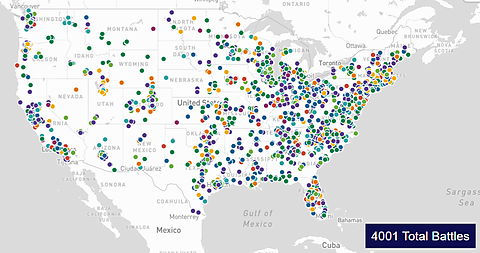Neal McCluskey
Yesterday, Cato’s Public Schooling Battle Map—an interactive database of values‐ and identity‐based conflicts in America’s public schools—surpassed 4,000 entries. At almost the exact time, we saw elite media coming to terms with divisive battles in public schools, including in such progressive strongholds as New York City:
The New York Times: “Name‐Calling and Calling the Police: How N.Y.C. Parent Meetings Got Mean”
The New Yorker: “The Meltdown at a Middle School in a Liberal Town”
The Washington Post: “America has legislated itself into competing red, blue versions of education”
What still has not been widely acknowledged is that culture war is inherent to public schooling, which forces people with differing values, desires, and needs to fund a single system of government schools. Perhaps this is because the fundamental nature of public schooling has not been clear to many reporters and commentators, who tend to focus on the combatants, such as Moms for Liberty, not the system that ignites the combat. Or perhaps the‐system‐as‐root‐cause is too abstract for daily reporting.
Or maybe public schooling still seems relatively peaceful.
While the Battle Map upends the presumption that public schooling is a unifying force, it only includes a small minority of school districts: 1,636, or roughly 12 percent of the nation’s 13,318. Most districts might seem peaceful, and many probably are—most people would probably prefer not to fight, if avoidable.
But 12 percent is a floor. The Map is populated almost exclusively by finding media reports, confirming there are conflicts, then cataloging the battles. But many school districts have small enrollments— about half have 999 or fewer students—and likely get little media coverage. This is reflected in the districts on the Map accounting for 46 percent of all public school enrollment, despite the small share of districts. We have also improved our sweep of news over the years, so we have likely missed many conflicts.
As I discuss in The Fractured Schoolhouse, local control has always been a way for people with different beliefs and backgrounds to congregate with like‐minded families and avoid much conflict. However, that has grown harder over the years as the number of districts is roughly a tenth of what it was less than a century ago and the population has gotten much larger.
Then there is this: As the Washington Post article above shows, a lot of education policy, including on hot‐button issues, is made at the state level. The Battle Map catalogues about 800 conflicts at that level, with every state having at least one and the average having nearly sixteen. When state government makes decisions, everyone in the state is on the battleground.
To defuse warfare in education and foster harmony, we need to move away from zero‐sum public schooling. Instead, funding should follow children to educational options their families choose, as is increasingly happening. It will not bring total peace, but as we have seen elsewhere, it will certainly help.
Peace, though, is not the primary reason to support educational freedom. That is liberty: Government taking money from everyone to fund schools it controls is fundamentally at odds with a free society. This is true even if families are allowed to consume private education after they have paid for government education. That still puts a massive thumb on the scale of government shaping children, and discriminates against families that want or need something different from what government provides.
The good news is many people are waking up to the divisive reality of public schooling. But we are still not seeing the critical examination we need.

